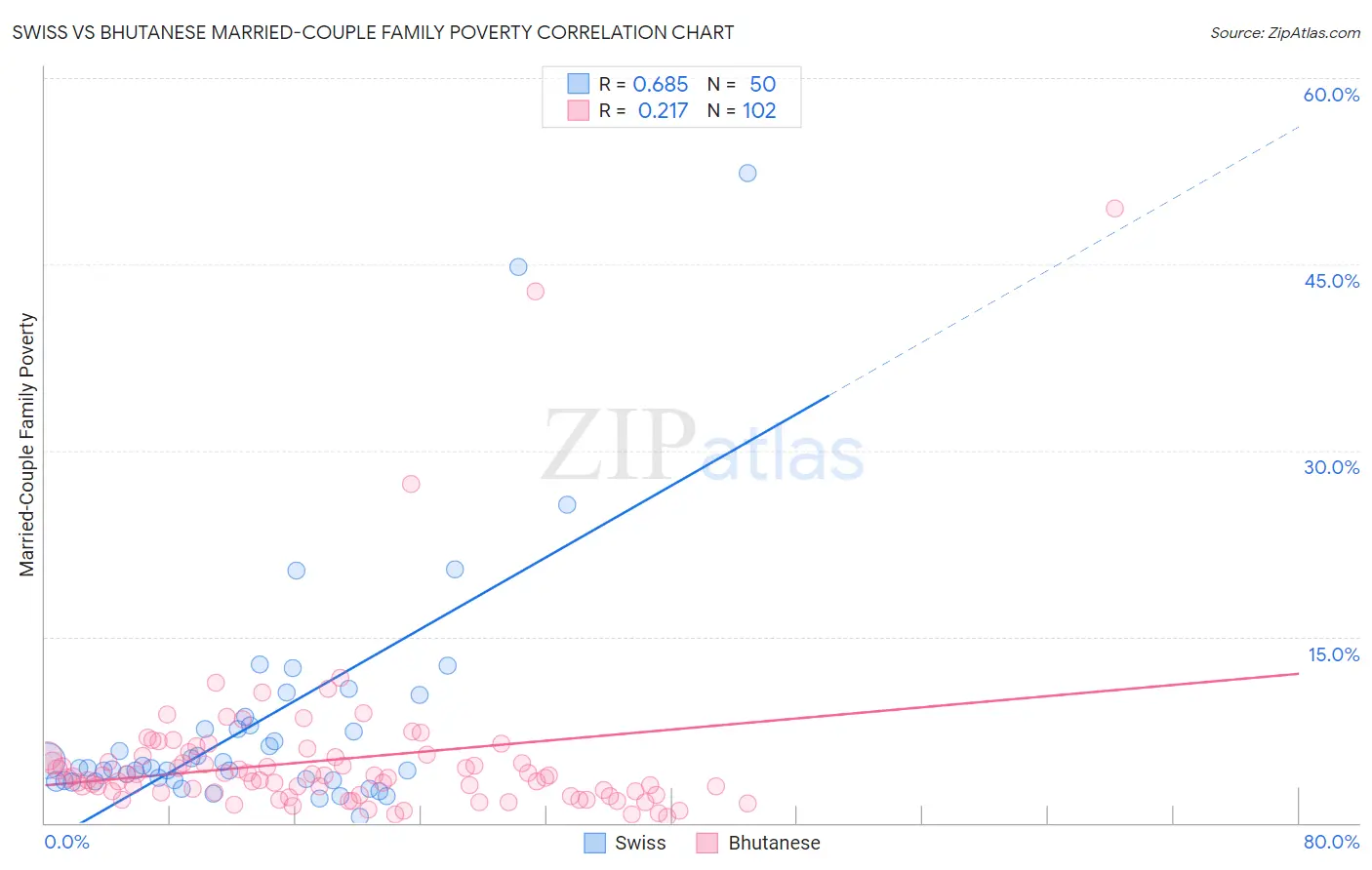Swiss vs Bhutanese Married-Couple Family Poverty
COMPARE
Swiss
Bhutanese
Married-Couple Family Poverty
Married-Couple Family Poverty Comparison
Swiss
Bhutanese
4.3%
MARRIED-COUPLE FAMILY POVERTY
99.8/ 100
METRIC RATING
43rd/ 347
METRIC RANK
4.1%
MARRIED-COUPLE FAMILY POVERTY
99.9/ 100
METRIC RATING
23rd/ 347
METRIC RANK
Swiss vs Bhutanese Married-Couple Family Poverty Correlation Chart
The statistical analysis conducted on geographies consisting of 457,863,093 people shows a significant positive correlation between the proportion of Swiss and poverty level among married-couple families in the United States with a correlation coefficient (R) of 0.685 and weighted average of 4.3%. Similarly, the statistical analysis conducted on geographies consisting of 450,291,687 people shows a weak positive correlation between the proportion of Bhutanese and poverty level among married-couple families in the United States with a correlation coefficient (R) of 0.217 and weighted average of 4.1%, a difference of 4.6%.

Married-Couple Family Poverty Correlation Summary
| Measurement | Swiss | Bhutanese |
| Minimum | 0.49% | 0.54% |
| Maximum | 52.4% | 49.5% |
| Range | 51.9% | 48.9% |
| Mean | 8.1% | 5.1% |
| Median | 4.4% | 3.7% |
| Interquartile 25% (IQ1) | 3.4% | 2.4% |
| Interquartile 75% (IQ3) | 7.8% | 5.4% |
| Interquartile Range (IQR) | 4.4% | 3.0% |
| Standard Deviation (Sample) | 9.8% | 6.7% |
| Standard Deviation (Population) | 9.7% | 6.7% |
Demographics Similar to Swiss and Bhutanese by Married-Couple Family Poverty
In terms of married-couple family poverty, the demographic groups most similar to Swiss are Scottish (4.3%, a difference of 0.44%), Northern European (4.3%, a difference of 0.60%), French Canadian (4.2%, a difference of 0.85%), Immigrants from Northern Europe (4.2%, a difference of 1.1%), and Belgian (4.2%, a difference of 1.3%). Similarly, the demographic groups most similar to Bhutanese are Eastern European (4.1%, a difference of 0.23%), Immigrants from Taiwan (4.1%, a difference of 0.81%), Cypriot (4.1%, a difference of 1.1%), Danish (4.1%, a difference of 1.2%), and Scandinavian (4.1%, a difference of 1.3%).
| Demographics | Rating | Rank | Married-Couple Family Poverty |
| Bhutanese | 99.9 /100 | #23 | Exceptional 4.1% |
| Eastern Europeans | 99.9 /100 | #24 | Exceptional 4.1% |
| Immigrants | Taiwan | 99.9 /100 | #25 | Exceptional 4.1% |
| Cypriots | 99.9 /100 | #26 | Exceptional 4.1% |
| Danes | 99.9 /100 | #27 | Exceptional 4.1% |
| Scandinavians | 99.9 /100 | #28 | Exceptional 4.1% |
| Immigrants | Scotland | 99.9 /100 | #29 | Exceptional 4.2% |
| Finns | 99.9 /100 | #30 | Exceptional 4.2% |
| Estonians | 99.9 /100 | #31 | Exceptional 4.2% |
| Greeks | 99.9 /100 | #32 | Exceptional 4.2% |
| Irish | 99.9 /100 | #33 | Exceptional 4.2% |
| Dutch | 99.9 /100 | #34 | Exceptional 4.2% |
| Europeans | 99.9 /100 | #35 | Exceptional 4.2% |
| English | 99.9 /100 | #36 | Exceptional 4.2% |
| Iranians | 99.9 /100 | #37 | Exceptional 4.2% |
| Belgians | 99.9 /100 | #38 | Exceptional 4.2% |
| Immigrants | Northern Europe | 99.8 /100 | #39 | Exceptional 4.2% |
| French Canadians | 99.8 /100 | #40 | Exceptional 4.2% |
| Northern Europeans | 99.8 /100 | #41 | Exceptional 4.3% |
| Scottish | 99.8 /100 | #42 | Exceptional 4.3% |
| Swiss | 99.8 /100 | #43 | Exceptional 4.3% |